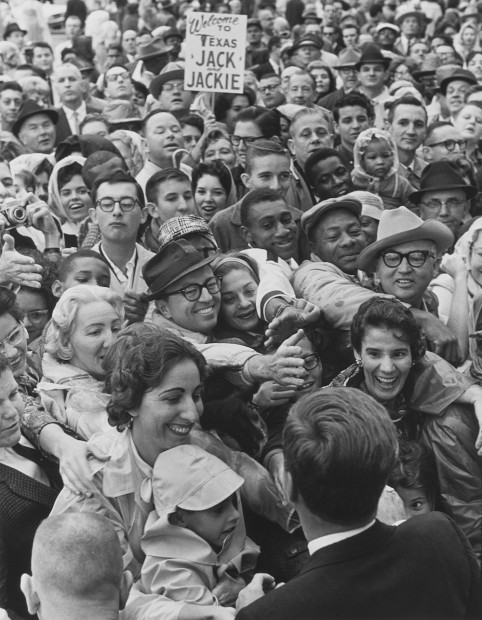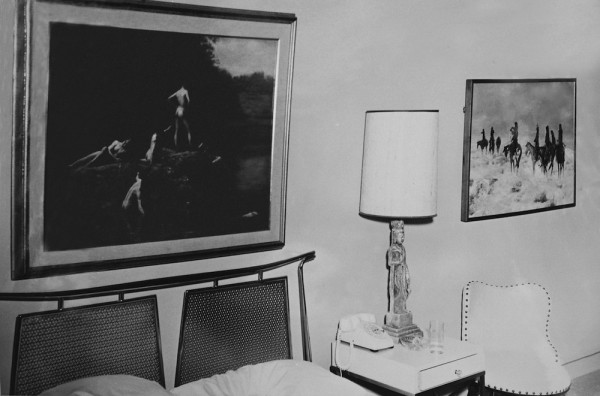
Gene Gordon, John F. Kennedy reaching out to crowd in Fort Worth
If you live in Dallas and you do much traveling, you realize that when people ask where you’re from you can just say “Dallas” and leave off the “Texas” or the “U.S.” part. Everyone from Tahiti to Romania to China knows where you mean. Dallas isn’t as big as scads of other metropolitan areas in the world you’ve never heard of, but thanks to Big Oil, and the television show Dallas (the first one), and the Dallas Cowboys, and the Kennedy assassination, Dallas is a place most of the world has pretty much sized up, for better and often for worse.
The older I get, the more I embrace its contradictions and stop apologizing for its profound shortcomings, but Dallas, the city, hasn’t stopped tearing itself in two while presenting its face to the rest of the country and the world: one minute it’s arrogant in the way only Texas can be, the next it’s embarrassed that it isn’t richer, greener, prettier, more cultured, better planned, historically more textured, fill in the blank.
Right. If Dallas could change one thing about its identity it would be One Thing: the fact that the 35th president of the United States was murdered, in cold blood, in front of thousands, in downtown Dallas. In one moment, Dallas went from being suspiciously a bit too conservative for his visit—putting Kennedy’s security detail on high alert—to being branded the City of Hate the world over, for years.
Fifty years on, Dallas is just now really emerging from the psychic hell-freeze caused by this debacle, and yet now it must face it head on, again, as the whole region braces for a major anniversary (commemoration? Not celebration. Reflection?) of one of our country’s most disastrous events. How strange. There are huge swaths of the local population that have no knowledge or interest in this (kind of) ancient history: people who were born after 1963, or who didn’t move here until recently, or who had never even heard of Kennedy until they got to middle school, or had never stumbled into Oliver Stone’s weird movie. Nonetheless, the breadth of the commemoration will be considerable. (I read that Mayor Rawlings flew to D.C. to beg one of the top dogs in some conspiracy cabal to call off his army of tin-foil hat people, who will no doubt descend on the grassy knoll in droves this fall. But I would guess tin-foil types don’t take orders from anyone.)
I wasn’t surprised to learn that the anniversary infiltration made its way early into the Dallas Museum of Art. Lucky for all of us, including those of us who would rather forget, Hotel Texas: An Art Exhibition for the President and Mrs. John F. Kennedy, organized mainly by the DMA’s Olivier Meslay with help from the Amon Carter, is a small, thoughtful gem of a show, and dense with emotion—a surprise grenade of grief, wishful thinking, and soul searching.
Hotel Texas is built on a deceptively simple premise: the show reunites the fifteen artworks that were temporarily installed in the presidential suite at Fort Worth’s Hotel Texas as a welcome for the president and first lady who slept there overnight on their visit to DFW. A group of Fort Worth art collectors had loaned some of their best pieces to the effort and carefully curated it to present the area in its best light.
I write “deceptive” because I arrived at the DMA with zero investment in any Kennedy lore whatsoever, yet upon entering the exhibition I felt tremendous sadness and appreciation. The entrance to the show is flanked by massive wall-spanning photos of Jack and Jackie (and the Secret Service) in both Fort Worth and Dallas, greeting throngs of eager, thrilled followers. Here he is, as he was to them—much larger than life, though in the requisite black and white, making it all the more nostalgic. There are also photos of the hotel suite itself (more modest than you would guess) with the borrowed artworks proudly and sweetly awaiting the First Couple’s arrival.
There’s a really touching photo of Fort Worth’s grinning, mischievous Ruth Carter Johnson and Lucille Weiner seat-belting Picasso’s bronze Angry Owl into the front of big bench-seat sedan; even fifty years ago they look so much like a current Deedie Potter Rose and Marguerite Hoffman, it’s haunting. This could have been yesterday. This could be tomorrow. (I know D and M would never ferry their bronzes themselves—they’ve got Unified Fine Art on speed dial—but you know what I mean.) That sense of everyone pitching in for such an event (and that people were so unjaded as to think of a president’s visit as special), everyone putting his or her best face forward, is heartbreaking. A full quarter of Dallas’ population lined the streets for Kennedy’s motorcade. That’s an astonishingly non-hateful gesture.

Suite 850, Hotel Texas, Fort Worth, Friday, November 22, 1963. Photo by Byron Scott.
Upon entering the exhibition proper, what strikes the viewer is how the actual artworks seem so self-contained and modest, and none sing louder than the others. The odd mix makes it feel casual and intimate, as though you’re in someone’s house and you’ve tiptoed off to look around. Most pieces still look very good (the aforementioned 1953 Picasso; Thomas Eakins’ Swimming, 1885), some look oddly charming, if not disarming (Sombrero and Gloves, Marsden Hartley, 1936), and some are pure pleasure to get to see at all (Vincent Van Gogh, Road With Peasant Shouldering a Spade, 1887. It’s really good). It’s an eclectic group; the selections are telling in what the collectors believed about themselves, their collections, the times they lived in, and their projections onto the president and his wife. The lights are low; there’s a kind of respectful quiet in the way the room feels. It’s easy to get close to the pieces and linger. It’s easy to feel quite sad.
As I walked through, I found myself appreciating more and more the very gesture of the show on behalf of the organizers. It was an act of goodwill. And something this small, because of its context, packs an unexpected wallop. I think that by focusing on a time when the president was still alive, the museum sidestepped all the sensationalism and exploitation and craziness of this upcoming anniversary. It’s dignified without being macabre.
Hotel Texas is in the Hoffman Galleries; a big room divider links it to DallaSITES: Charting Contemporary Art, 1963 to Present, which is a timeline/documentation of the Dallas art scene. It opened alongside Hotel Texas, but DallaSITES is in progress because much of the art action will take place in the quadrant galleries and Barrel Vault in the coming months under the subhead “Available Space,” showcasing current artists and collectives of artists, like Homecoming!, the Art Foundation, and Dallas VideoFest. The two shows make a good pairing, or they will, once the quadrants get fired up—a way of bringing a viewer out of the torpor of the past and into the present, as Dallas itself is so keen to do.
But Hotel Texas makes me wish we could save a few pages from that tormented past— namely the grace and thoughtfulness with which the planners of the Kennedys’ visit went about making their stay here as positive and sophisticated as possible, all the way up to the shooting.
Hotel Texas is the kind of show I’d like to see more often at the DMA. Dense, personal, and making a major impact in a small area. Former DMA curator Suzanne Weaver’s Concentrations series managed to deliver such satisfaction for years (with solo shows by emerging artists), and then she left. Shows like this feel sincere, respect the artwork, and derive context from something far more profound than moneymaking blockbusterness. If the DMA could get back to more of that, it could help Dallas along its way to lasting self-respect.



4 comments
rumor has it that jfk did not sleep in that room that night
Well, Jackie was the art lover anyway.
like
CHRISTINA REES commentss about Former DMA curator Suzanne Weaver’s Concentrations series are right on target. Thanks for commenting on her exhibits.
As for the assassination of President Kennedy, for those of us who remember the time, we still remember the level of hate mongoring that was in the air. It is acceptance of such a detestable climate, too close to what we hear spouted today, that causes us to still have the painful feeling of enormous loss that we feel 50 years later.